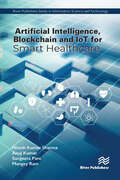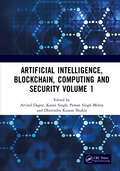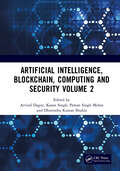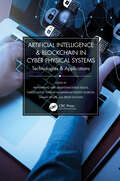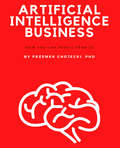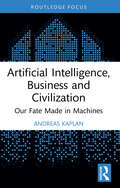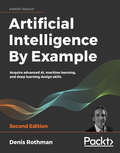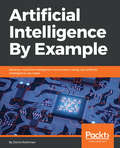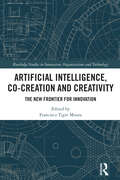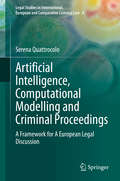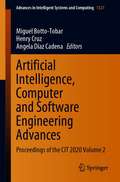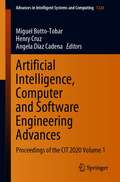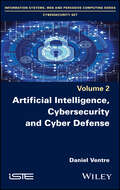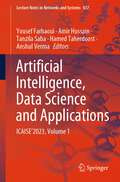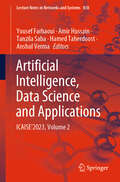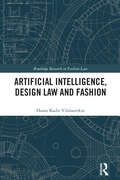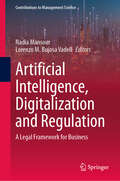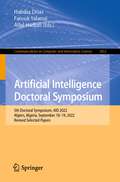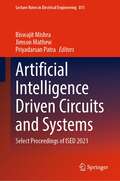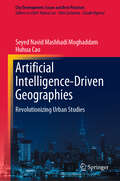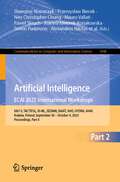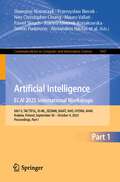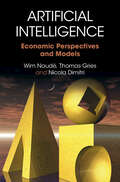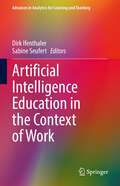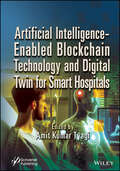- Table View
- List View
Artificial Intelligence, Blockchain and IoT for Smart Healthcare
by Hitesh Kumar Sharma Anuj Kumar Sangeeta Pant Mangey RamThe concepts of telemedicine and e-healthcare have eased as well as improved the reachability of experienced doctors and medical staff to remote patients. A patient who is living in a remote village area can directly connect to specialist doctors across the globe though his/her mobile phone using telemedicine systems and e-healthcare services. In pandemic situations like COVID-19, these online platforms helped society to get medical treatment from their residence without any physical movement. Technology is transforming human lives by playing an important role in the planning, designing, and development of intelligent systems for better service. This book presents a cross-disciplinary perspective on the concept of machine learning, blockchain and IoT by congregating cutting-edge research and insights. It also identifies and discusses various advanced technologies such as internet of things (IoT), big data analytics, machine learning, artificial intelligence, cyber security, cloud computing, sensors and so on that are vital to foster the development of smart healthcare and telemedicine systems by providing effective solutions to the medical challenges faced by humankind.
Artificial Intelligence, Blockchain, Computing and Security Volume 1: Proceedings of the International Conference on Artificial Intelligence, Blockchain, Computing and Security (ICABCS 2023), Gr. Noida, UP, India, 24 - 25 February 2023
by Arvind Dagur Karan Singh Pawan Singh Mehra Dhirendra Kumar ShuklaThis book contains the conference proceedings of ICABCS 2023, a non-profit conference with the objective to provide a platform that allows academicians, researchers, scholars and students from various institutions, universities and industries in India and abroad to exchange their research and innovative ideas in the field of Artificial Intelligence, Blockchain, Computing and Security. It explores the recent advancement in field of Artificial Intelligence, Blockchain, Communication and Security in this digital era for novice to profound knowledge about cutting edges in artificial intelligence, financial, secure transaction, monitoring, real time assistance and security for advanced stage learners/ researchers/ academicians. The key features of this book are: Broad knowledge and research trends in artificial intelligence and blockchain with security and their role in smart living assistance Depiction of system model and architecture for clear picture of AI in real life Discussion on the role of Artificial Intelligence and Blockchain in various real-life problems across sectors including banking, healthcare, navigation, communication, security Explanation of the challenges and opportunities in AI and Blockchain based healthcare, education, banking, and related industries This book will be of great interest to researchers, academicians, undergraduate students, postgraduate students, research scholars, industry professionals, technologists, and entrepreneurs.
Artificial Intelligence, Blockchain, Computing and Security Volume 2: Proceedings of the International Conference on Artificial Intelligence, Blockchain, Computing and Security (ICABCS 2023), Gr. Noida, UP, India, 24 - 25 February 2023
by Arvind Dagur Karan Singh Pawan Singh Mehra Dhirendra Kumar ShuklaThis book contains the conference proceedings of ICABCS 2023, a non-profit conference with the objective to provide a platform that allows academicians, researchers, scholars and students from various institutions, universities and industries in India and abroad to exchange their research and innovative ideas in the field of Artificial Intelligence, Blockchain, Computing and Security. It explores the recent advancement in field of Artificial Intelligence, Blockchain, Communication and Security in this digital era for novice to profound knowledge about cutting edges in artificial intelligence, financial, secure transaction, monitoring, real time assistance and security for advanced stage learners/ researchers/ academicians. The key features of this book are: Broad knowledge and research trends in artificial intelligence and blockchain with security and their role in smart living assistance Depiction of system model and architecture for clear picture of AI in real life Discussion on the role of Artificial Intelligence and Blockchain in various real-life problems across sectors including banking, healthcare, navigation, communication, security Explanation of the challenges and opportunities in AI and Blockchain based healthcare, education, banking, and related industries This book will be of great interest to researchers, academicians, undergraduate students, postgraduate students, research scholars, industry professionals, technologists, and entrepreneurs.
Artificial Intelligence & Blockchain in Cyber Physical Systems: Technologies & Applications
by Muhammad Arif Faseeh QureshiThis book explores the intersection of blockchain technology, artificial intelligence (AI) and cyber physical systems (CPS). It discusses how these technologies can be integrated to create secure and efficient CPS solutions. The book covers various topics, including the basics of blockchain and AI, their applications in CPS and the challenges of integrating these technologies. It also explores real-world examples of how blockchain and AI are used in CPS, such as smart cities, transportation systems and healthcare. The authors delve into the technical aspects of how blockchain and AI can be used together to enhance CPS security, data privacy and interoperability. They also discuss the potential benefits and limitations of these technologies and provide insights into the future of CPS. Overall, this book provides a comprehensive overview of the use of blockchain and AI in CPS, making it a valuable resource for researchers, professionals and students in the fields of computer science, engineering and cybersecurity.
Artificial Intelligence Business: Expert tips and techniques for how to profit from AI
by Przemek ChojeckiThe concise guide to artificial intelligence for business people and commercially oriented data scientists Key Features • Find out how artificial intelligence is shaping the future of businesses • Discover how AI influences the society and its politics and economy • Explore the future of AI and its applications Book Description We're living in revolutionary times. Artificial intelligence is changing how the world operates and it determines how smooth certain processes are. For instance, when you go on a holiday, multiple services allow you to find the most convenient flights and the best hotels, you get personalized suggestions on what you might want to see, and you go to the airport via one of the ride-sharing apps. At each of these steps, AI algorithms are at work for your convenience. This book will guide you through everything, from what AI is to how it influences our economy and society. The book starts with an introduction to artificial intelligence and machine learning, and explains the importance of AI in the modern world. You'll explore how start-ups make key decisions with AI and how AI plays a major role in boosting businesses. Next, you'll find out how media companies use image generation techniques to create engaging content. As you progress, you'll explore how text generation and AI chatbot models simplify our daily lives. Toward the end, you'll understand the importance of AI in the education and healthcare sectors, and realize the risks associated with AI and how we can leverage AI effectively to help us in the future. By the end of this book, you'll have learned how machine learning works and have a solid understanding of the recent business applications of AI. What you will learn • Find out how AI helps in building innovative cultures in enterprises • Understand how AI boosts start-ups • Discover modern AI trends in the field of manufacturing and logistics • Explore the benefits of text and image generation applications • Study popular machine learning trends and their usage • Uncover the uses of AI in politics and society Who this book is for This book is for artificial intelligence enthusiasts or anyone with a business background who wants to learn how AI can scale up businesses.
Artificial Intelligence, Business and Civilization: Our Fate Made in Machines (Routledge Focus on Business and Management)
by Andreas KaplanArtificial intelligence is shaking up economies around the world as well as society at large and is predicted to be either the best or worst thing to happen to humanity. This book looks at what exactly artificial intelligence is, how it can be classified, how it differentiates from other concepts such as machine learning, big data, blockchain, or the Internet-of-Things, and how it has evolved and might evolve over time. Providing a clear and unbiased picture of artificial intelligence, the book provides critical analyses of the advantages and disadvantages, opportunities and threats of AI progress for business and civilisation. Solutions and possible directions of how humanity might deal with rapid development and evolutions will be given and discussed, and consider regulation, employment, ethics, education and international cooperation. Unlike existing literature, this book provides a comprehensive overview of AI based on detailed analysis and insight. Finally, several real-life examples from various sectors and industries, including for profit organizations, higher education, and government, will substantiate and illustrate the presented concepts, classifications, and discussions. This book is of interest to researchers, educators, students, and practitioners alike who desire to understand AI in its broad lines and discover the latest research and studies within the field.
Artificial Intelligence By Example: Acquire advanced AI, machine learning, and deep learning design skills, 2nd Edition
by Denis RothmanUnderstand the fundamentals and develop your own AI solutions in this updated edition packed with many new examples Key Features AI-based examples to guide you in designing and implementing machine intelligence Build machine intelligence from scratch using artificial intelligence examples Develop machine intelligence from scratch using real artificial intelligence Book Description AI has the potential to replicate humans in every field. Artificial Intelligence By Example, Second Edition serves as a starting point for you to understand how AI is built, with the help of intriguing and exciting examples. This book will make you an adaptive thinker and help you apply concepts to real-world scenarios. Using some of the most interesting AI examples, right from computer programs such as a simple chess engine to cognitive chatbots, you will learn how to tackle the machine you are competing with. You will study some of the most advanced machine learning models, understand how to apply AI to blockchain and Internet of Things (IoT), and develop emotional quotient in chatbots using neural networks such as recurrent neural networks (RNNs) and convolutional neural networks (CNNs). This edition also has new examples for hybrid neural networks, combining reinforcement learning (RL) and deep learning (DL), chained algorithms, combining unsupervised learning with decision trees, random forests, combining DL and genetic algorithms, conversational user interfaces (CUI) for chatbots, neuromorphic computing, and quantum computing. By the end of this book, you will understand the fundamentals of AI and have worked through a number of examples that will help you develop your AI solutions. What you will learn Apply k-nearest neighbors (KNN) to language translations and explore the opportunities in Google Translate Understand chained algorithms combining unsupervised learning withdecision trees Solve the XOR problem with feedforward neural networks (FNN) and buildits architecture to represent a data flow graph Learn about meta learning models withhybrid neural networks Create a chatbot and optimize its emotional intelligence deficiencies withtools such as Small Talk and data logging Building conversational user interfaces (CUI) for chatbots Writing genetic algorithms that optimizedeep learning neural networks Build quantum computing circuits Who this book is for Developers and those interested in AI, who want to understand the fundamentals of Artificial Intelligence and implement them practically. Prior experience with Python programming and statistical knowledge is essential to make the most out of this book.
Artificial Intelligence By Example: Develop machine intelligence from scratch using real artificial intelligence use cases
by Denis RothmanBe an adaptive thinker that leads the way to Artificial IntelligenceKey FeaturesAI-based examples to guide you in designing and implementing machine intelligenceDevelop your own method for future AI solutionsAcquire advanced AI, machine learning, and deep learning design skillsBook DescriptionArtificial Intelligence has the potential to replicate humans in every field. This book serves as a starting point for you to understand how AI is built, with the help of intriguing examples and case studies.Artificial Intelligence By Example will make you an adaptive thinker and help you apply concepts to real-life scenarios. Using some of the most interesting AI examples, right from a simple chess engine to a cognitive chatbot, you will learn how to tackle the machine you are competing with. You will study some of the most advanced machine learning models, understand how to apply AI to blockchain and IoT, and develop emotional quotient in chatbots using neural networks.You will move on to designing AI solutions in a simple manner rather than get confused by complex architectures and techniques. This comprehensive guide will be a starter kit for you to develop AI applications on your own.By the end of this book, will have understood the fundamentals of AI and worked through a number of case studies that will help you develop business vision.What you will learnUse adaptive thinking to solve real-life AI case studiesRise beyond being a modern-day factory code workerAcquire advanced AI, machine learning, and deep learning designing skillsLearn about cognitive NLP chatbots, quantum computing, and IoT and blockchain technologyUnderstand future AI solutions and adapt quickly to themDevelop out-of-the-box thinking to face any challenge the market presentsWho this book is forArtificial Intelligence by Example is a simple, explanatory, and descriptive guide for junior developers, experienced developers, technology consultants, and those interested in AI who want to understand the fundamentals of Artificial Intelligence and implement it practically by devising smart solutions. Prior experience with Python and statistical knowledge is essential to make the most out of this book.
Artificial Intelligence, Co-Creation and Creativity: The New Frontier for Innovation (Routledge Studies in Innovation, Organizations and Technology)
by Francisco Tigre MouraArtificial intelligence (AI) has deeply impacted our understanding of creativity and the human ability to generate creative outputs. New applications for creative tasks are rapidly evolving, and new tools are constantly being developed with much greater optimal capabilities. Importantly, the success of implementing such tools for creative tasks is still heavily dependent on human supervision and input. Therefore, it is vital to understand and critically reflect on the nature of co-creative processes between humans and AI. This book addresses such issues and provides insights into how humans can augment their capabilities for generating creative and innovative outputs by successfully co-creating with AI.The book is intentionally divided into three main parts to allow for a comprehensive and holistic perspective on human and AI co-creation for creative tasks. The sections are divided as follows: Part 1: “Principles of AI and Creativity”, Part 2: “Critical Issues on Artificial Co-Creation”, and Part 3: “Industry-Specific Discussions”.Consequently, the book provides a holistic insight on the topic, covering various issues and perspectives and enabling an accessible read to a broad audience. For example, chapters cover examples across different industry sectors, including music, arts, science, and management. Furthermore, the book covers critical questions involving copyrights, ethical concerns, relationship with algorithms, and context-based issues. Only by critically reflecting on the intrinsic issues of AI and learning how to work with it effectively for creative purposes will we be able to benefit from its full potential to augment human creative abilities in an appropriate manner.This novel, edited collection is an essential read for scholars working on the intersection of AI, creativity, arts, and management.
Artificial Intelligence, Computational Modelling and Criminal Proceedings: A Framework for A European Legal Discussion (Legal Studies in International, European and Comparative Criminal Law #4)
by Serena QuattrocoloThis book discusses issues relating to the application of AI and computational modelling in criminal proceedings from a European perspective. Part one provides a definition of the topics. Rather than focusing on policing or prevention of crime – largely tackled by recent literature – it explores ways in which AI can affect the investigation and adjudication of crime. There are two main areas of application: the first is evidence gathering, which is addressed in Part two. This section examines how traditional evidentiary law is affected by both new ways of investigation – based on automated processes (often using machine learning) – and new kinds of evidence, automatically generated by AI instruments. Drawing on the comprehensive case law of the European Court of Human Rights, it also presents reflections on the reliability and, ultimately, the admissibility of such evidence. Part three investigates the second application area: judicial decision-making, providing an unbiased review of the meaning, benefits, and possible long-term effects of ‘predictive justice’ in the criminal field. It highlights the prediction of both violent behaviour, or recidivism, and future court decisions, based on precedents. Touching on the foundations of common law and civil law traditions, the book offers insights into the usefulness of ‘prediction’ in criminal proceedings.
Artificial Intelligence, Computer and Software Engineering Advances: Proceedings of the CIT 2020 Volume 2 (Advances in Intelligent Systems and Computing #1327)
by Miguel Botto-Tobar Henry Cruz Angela Díaz CadenaThis book constitutes the proceedings of the XV Multidisciplinary International Congress on Science and Technology (CIT 2020), held in Quito, Ecuador, on 26–30 October 2020, proudly organized by Universidad de las Fuerzas Armadas ESPE in collaboration with GDEON. CIT is an international event with a multidisciplinary approach that promotes the dissemination of advances in Science and Technology research through the presentation of keynote conferences. In CIT, theoretical, technical, or application works that are research products are presented to discuss and debate ideas, experiences, and challenges. Presenting high-quality, peer-reviewed papers, the book discusses the following topics:Artificial IntelligenceComputational ModelingData CommunicationsDefense EngineeringInnovation, Technology, and SocietyManaging Technology & Sustained Innovation, and Business DevelopmentModern Vehicle TechnologySecurity and CryptographySoftware Engineering
Artificial Intelligence, Computer and Software Engineering Advances: Proceedings of the CIT 2020 Volume 1 (Advances in Intelligent Systems and Computing #1326)
by Miguel Botto-Tobar Henry Cruz Angela Díaz CadenaThis book constitutes the proceedings of the XV Multidisciplinary International Congress on Science and Technology (CIT 2020), held in Quito, Ecuador, on 26–30 October 2020, proudly organized by Universidad de las Fuerzas Armadas ESPE in collaboration with GDEON. CIT is an international event with a multidisciplinary approach that promotes the dissemination of advances in Science and Technology research through the presentation of keynote conferences. In CIT, theoretical, technical, or application works that are research products are presented to discuss and debate ideas, experiences, and challenges. Presenting high-quality, peer-reviewed papers, the book discusses the following topics:Artificial IntelligenceComputational ModelingData CommunicationsDefense EngineeringInnovation, Technology, and SocietyManaging Technology & Sustained Innovation, and Business DevelopmentModern Vehicle TechnologySecurity and CryptographySoftware Engineering
Artificial Intelligence, Cybersecurity and Cyber Defence
by Daniel VentreThe aim of the book is to analyse and understand the impacts of artificial intelligence in the fields of national security and defense; to identify the political, geopolitical, strategic issues of AI; to analyse its place in conflicts and cyberconflicts, and more generally in the various forms of violence; to explain the appropriation of artificial intelligence by military organizations, but also law enforcement agencies and the police; to discuss the questions that the development of artificial intelligence and its use raise in armies, police, intelligence agencies, at the tactical, operational and strategic levels.
Artificial Intelligence, Data Science and Applications: ICAISE’2023, Volume 1 (Lecture Notes in Networks and Systems #837)
by Yousef Farhaoui Amir Hussain Tanzila Saba Hamed Taherdoost Anshul VermaThis book is to provide a comprehensive reference for professionals in the field of data science and applications: artificial intelligence, big data, IoT, and blockchain. In summary, this book is expected to function as a helpful resource and manual, enabling readers to navigate the intricate domain of artificial intelligence, the Internet of things (IoT), and blockchain in smart environments. This book covers many topics related to integrating AI, IoT, blockchain, and smart environments. It begins by laying a solid foundation, introducing each technology's fundamental concepts and principles. Subsequent chapters explore applications and real-world use cases, demonstrating how AI, IoT, and blockchain can effectively address critical challenges within data science and applications.
Artificial Intelligence, Data Science and Applications: ICAISE’2023, Volume 2 (Lecture Notes in Networks and Systems #838)
by Yousef Farhaoui Amir Hussain Tanzila Saba Hamed Taherdoost Anshul VermaThis book is to provide a comprehensive reference for professionals in the field of data science and applications: artificial intelligence, big data, IoT, and blockchain. In summary, this book is expected to function as a helpful resource and manual, enabling readers to navigate the intricate domain of artificial intelligence, the Internet of things (IoT), and blockchain in smart environments. This book covers many topics related to integrating AI, IoT, blockchain, and smart environments. It begins by laying a solid foundation, introducing each technology's fundamental concepts and principles. Subsequent chapters explore applications and real-world use cases, demonstrating how AI, IoT, and blockchain can effectively address critical challenges within data science and applications.
Artificial Intelligence, Design Law and Fashion (Routledge Research in Fashion Law)
by Hasan Kadir YılmaztekinArtificial intelligence (AI) now infiltrates our culture. After a couple of difficult winters, AI today is a word on everybody’s lips, and it attracts everyone’s attention regardless of whether they are experts or not. From Apple’s Siri to Amazon’s Alexa, Tesla’s auto-driving cars to facial recognition systems in CCTV cameras, Netflix’s film offering services to Google’s search engine, we live in a world of AI goods. The advent of AI-powered technologies increasingly affects people’s lives across the globe. As a tool for productivity and cost-efficiency, AI also shapes our economy and welfare. AI-generated designs and works are becoming more popular. Today, AI technologies can generate several intellectual creations. Fashion is one of the industries that AI can profoundly impact. AI tools and devices are currently being used in the fashion industry to create fashion models, fabric and jewellery designs, and clothing. When we talk about AI-generated designs, we instead focus on the fruits of innovation – more best-selling apparels, more fashionable designs and more fulfilment of customer expectations – without paying heed to who the designer is. Designers invest a lot of talent, time and finances into designing and creating each article of clothing and accessory before they release their work to the public. Pattern drafting is the first and most important step in dressmaking. Designers typically start with a general sketch on paper; add styles, elements and colours; revise and refine everything; and finally deliver their design to dressmakers. AI accelerates this time-consuming and labour-intensive process. Yet the full legal consequences of AI in fashion industry are often forgotten. An AI device’s ability to generate fashion designs raises the question of who will own intellectual property rights over the fashion designs. Will it be the fashion designer who hires or contracts with the AI programmer? Will it be the programmer? Will it be the AI itself? Or will it be a joint work of humans and computers? And who will be liable for infringement deriving from use of third-party material in AI-generated fashion designs? This book explores answers to these questions within the framework of EU design and copyright laws. It also crafts a solution proposal based on a three-step test and model norms, which could be used to unleash the authors, rights holders and infringers around AI-generated fashion designs.
Artificial Intelligence, Digitalization and Regulation: A Legal Framework for Business (Contributions to Management Science)
by Nadia Mansour Lorenzo M. Bujosa VadellThis edited volume explores the relationship between Artificial intelligence (AI), business performance, and regulation. Artificial intelligence allows entrepreneurs to create universally transferable platforms and customers to find the offer they want. Indeed, AI is an excellent tool for competitiveness and innovation. It can contribute to a positive business performance by reducing costs, analyzing and exploiting data, optimizing marketing strategy and advertising targeting, and improving the customer experience. However, Artificial intelligence can also generate threats such as disinformation, manipulation, and false content. Companies are increasingly becoming obliged to take security measures to protect digital data against cyber-attacks and data leaks. This volume presents concepts and solutions for companies aiming not only to benefit from the newest technological developments in AI but also interested in tackling the challenges that come with the use of these technologies.
Artificial Intelligence Doctoral Symposium: 5th Doctoral Symposium, AID 2022, Algiers, Algeria, September 18–19, 2022, Revised Selected Papers (Communications in Computer and Information Science #1852)
by Habiba Drias Farouk Yalaoui Allel HadjaliThis volume constitutes selected papers presented during the 5th Artificial Intelligence Doctoral Symposium, AID 2022, held in Algiers, Algeria, in September 2022. The 22 presented full papers were thoroughly reviewed and selected from the 38 qualified submissions. They are organized in the following topical sections: data mining; metaheuristics and swarm intelligence; computer vision; Artificial Intelligence applications; machine and deep learning; NLP and text mining.
Artificial Intelligence Driven Circuits and Systems: Select Proceedings of ISED 2021 (Lecture Notes in Electrical Engineering #811)
by Biswajit Mishra Jimson Mathew Priyadarsan PatraThis book highlights selected papers presented at the 10th International Symposium on Embedded Computing and System Design (ISED) 2021. This symposium provides a platform for researchers to share the latest scientific achievements of embedded computing and system design. The book is divided into three broad sections. The first section discusses topics like VLSI and testing, circuits and systems with a focus on emerging technologies. The second section discusses topics like embedded hardware and software systems and novel applications. The final section discusses the state-of-the-art technologies involving IoT, artificial intelligence, green and edge computing that demonstrates the issues currently.
Artificial Intelligence-Driven Geographies: Revolutionizing Urban Studies (City Development: Issues and Best Practices)
by Huhua Cao Seyed Navid MoghaddamThis groundbreaking book delves deep into the history of AI, the major techniques and algorithms of machine learning and deep learning, and the critical role of data sources and processing in these disciplines. It covers a range of AI applications in human geography, including population distribution, land use, environmental risk assessment, and socioeconomic analysis. In urban planning, the book explores AI-driven approaches to smart cities, transportation management, urban growth prediction, and sustainable development, among others. As AI continues to permeate every aspect of human life, it is essential to understand and address the ethical considerations and challenges associated with AI-driven planning. This book tackles crucial issues such as data privacy, algorithmic bias, equitable access to technology, and the future of employment in the fields of geography and urban planning. In addition, it presents inspiring case studies, highlighting successful AI applications in human geography and urban planning, and offers insights into future research directions and challenges. This book is a must-read for students, researchers, and professionals in geography, urban planning, environmental studies, and related fields. It is also an invaluable resource for policymakers and urban planners seeking to leverage the power of AI to create smarter, more sustainable, and equitable cities and communities. This book equips you with the knowledge and tools to harness the potential of AI, leading the way to a better understanding of our world and a brighter future for all.
Artificial Intelligence. ECAI 2023 International Workshops: XAI^3, TACTIFUL, XI-ML, SEDAMI, RAAIT, AI4S, HYDRA, AI4AI, Kraków, Poland, September 30 – October 4, 2023, Proceedings, Part II (Communications in Computer and Information Science #1948)
by Sławomir Nowaczyk Przemysław Biecek Neo Christopher Chung Mauro Vallati Paweł Skruch Joanna Jaworek-Korjakowska Simon Parkinson Alexandros Nikitas Martin Atzmüller Tomáš Kliegr Ute Schmid Szymon Bobek Nada Lavrac Marieke Peeters Roland Van Dierendonck Saskia Robben Eunika Mercier-Laurent Gülgün Kayakutlu Mieczyslaw Lech Owoc Karl Mason Abdul Wahid Pierangela Bruno Francesco Calimeri Francesco Cauteruccio Giorgio Terracina Diedrich Wolter Jochen L. Leidner Michael Kohlhase Vania DimitrovaThis volume constitutes the refereed proceedings presented at the international workshops of the 26th European Conference on Artificial Intelligence, ECAI 2023, which was held in Kraków, Poland, in September-October 2023. The papers in this volume were presented at the following workshops: XAI^3, TACTIFUL, XI-ML, SEDAMI, RAAIT, AI4S, HYDRA, AI4AI.
Artificial Intelligence. ECAI 2023 International Workshops: XAI^3, TACTIFUL, XI-ML, SEDAMI, RAAIT, AI4S, HYDRA, AI4AI, Kraków, Poland, September 30 – October 4, 2023, Proceedings, Part I (Communications in Computer and Information Science #1947)
by Sławomir Nowaczyk Przemysław Biecek Neo Christopher Chung Mauro Vallati Paweł Skruch Joanna Jaworek-Korjakowska Simon Parkinson Alexandros Nikitas Martin Atzmüller Tomáš Kliegr Ute Schmid Szymon Bobek Nada Lavrac Marieke Peeters Roland Van Dierendonck Saskia Robben Eunika Mercier-Laurent Gülgün Kayakutlu Mieczyslaw Lech Owoc Karl Mason Abdul Wahid Pierangela Bruno Francesco Calimeri Francesco Cauteruccio Giorgio Terracina Diedrich Wolter Jochen L. Leidner Michael Kohlhase Vania DimitrovaThis volume constitutes the refereed proceedings presented at the international workshops of the 26th European Conference on Artificial Intelligence, ECAI 2023, which was held in Kraków, Poland, in September-October 2023. The papers in this volume were presented at the following workshops: XAI^3, TACTIFUL, XI-ML, SEDAMI, RAAIT, AI4S, HYDRA, AI4AI.
Artificial Intelligence: Economic Perspectives and Models
by Wim Naudé Thomas Gries and Nicola DimitriIs Artificial Intelligence a more significant invention than electricity? Will it result in explosive economic growth and unimaginable wealth for all, or will it cause the extinction of all humans? Artificial Intelligence: Economic Perspectives and Models provides a sober analysis of these questions from an economics perspective. It argues that to better understand the impact of AI on economic outcomes, we must fundamentally change the way we think about AI in relation to models of economic growth. It describes the progress that has been made so far and offers two ways in which current modelling can be improved: firstly, to incorporate the nature of AI as providing abilities that complement and/or substitute for labor, and secondly, to consider demand-side constraints. Outlining the decision-theory basis of both AI and economics, this book shows how this, and the incorporation of AI into economic models, can provide useful tools for safe, human-centered AI.
Artificial Intelligence Education in the Context of Work (Advances in Analytics for Learning and Teaching)
by Dirk Ifenthaler Sabine SeufertThis edited volume remedies existing deficiencies in the literature on artificial intelligence and education in the context of work. The topics addressed by this book are: • Supporting formal and informal learning through AI• Human-machine collaboration for learning at the workplace, including the potential of human-AI interaction in professional and vocational education contexts, design, use, and evaluation of human-AI hybrid systems for learning• Intelligent and Interactive Technologies for Learning, including natural language processing and speech technologies; data mining and machine learning; knowledge representation and reasoning; semantic web technologies, chat bot-mediated learning, and conversational learning, • AI-enabled applications for skills management and personalized learning, such as AI-enabled coaching, personalized skill management, and intelligent tutoring systems. • Case studies for the implementation and use of AI-enabled learning and performance solutions, such as personal learning experience platforms, and automated performance feedback.
Artificial Intelligence-Enabled Blockchain Technology and Digital Twin for Smart Hospitals
by Amit Kumar TyagiThe book uniquely explores the fundamentals of blockchain and digital twin and their uses in smart hospitals. Artificial Intelligence-Enabled Blockchain Technology and Digital Twin for Smart Hospitals provides fundamental information on blockchain and digital twin technology as effective solutions in smart hospitals. Digital twin technology enables the creation of real-time virtual replicas of hospital assets and patients, enhancing predictive maintenance, operational efficiency, and patient care. Blockchain technology provides a secure and transparent platform for managing and sharing sensitive data, such as medical records and pharmaceutical supply chains. By combining these technologies, smart hospitals can ensure data security, interoperability, and streamlined operations while providing patient-centered care. The book also explores the impact of collected medical data from real-time systems in smart hospitals, and by making it accessible to all doctors via a smartphone or mobile device for fast decisions. Inevitable challenges such as privacy concerns and integration costs must, of course, be addressed. However, the potential benefits in terms of improved healthcare quality, reduced costs, and global health initiatives makes the integration of these technologies a compelling avenue for the future of healthcare. Some of the topics that readers will find in this book include: Wireless Medical Sensor Networks in Smart Hospitals ● DNA Computing in Cryptography ● Enhancing Diabetic Retinopathy and Glaucoma Diagnosis through Efficient Retinal Vessel Segmentation and Disease Classification ● Machine Learning-Enabled Digital Twins for Diagnostic And Therapeutic Purposes ● Blockchain as the Backbone of a Connected Ecosystem of Smart Hospitals ● Blockchain for Edge Association in Digital Twin Empowered 6G Networks ● Blockchain for Security and Privacy in Smart Healthcare ● Blockchain-Enabled Internet of Things (IoTs) Platforms for IoT-Based Healthcare and Biomedical Sector ● Electronic Health Records in a Blockchain ● PSO-Based Hybrid Cardiovascular Disease Prediction for Using Artificial Flora Algorithm ● AI and Transfer Learning Based Framework for Efficient Classification And Detection Of Lyme Disease ● Framework for Gender Detection Using Facial Countenances ● Smartphone-Based Sensors for Biomedical Applications ● Blockchain for Improving Security and Privacy in the Smart Sensor Network ● Sensors and Digital Twin Application in Healthcare Facilities Management ● Integration of Internet of Medical Things (IoMT) with Blockchain Technology to Improve Security and Privacy ● Machine Learning-Driven Digital Twins for Precise Brain Tumor and Breast Cancer Assessment ● Ethical and Technological Convergence: AI and Blockchain in Halal Healthcare ● Digital Twin Application in Healthcare Facilities Management ● Cloud-based Digital Twinning for Structural Health Monitoring Using Deep Learning. Audience The book will be read by hospital and healthcare providers, administrators, policymakers, scientists and engineers in artificial intelligence, information technology, electronics engineering, and related disciplines.
